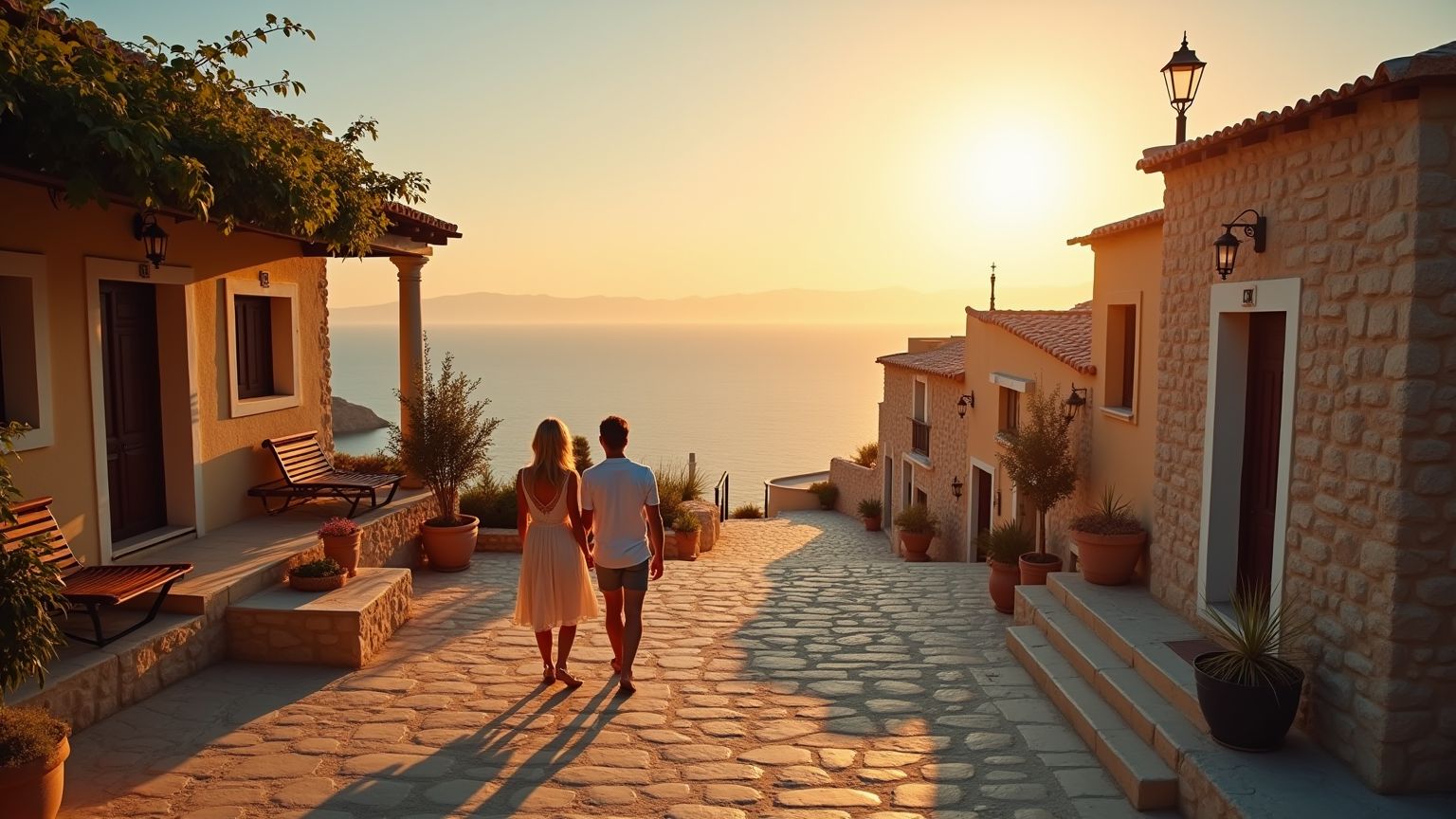Hidden Greece: A Traveler’s Guide to the Untamed Mani Greece Peninsula
Twenty years of leading tours across Greece has taught me one unshakable truth: Mani, Greece remains the country's crown jewel that somehow escaped the tourist brochures. This defiant fist of land punches southward from the Peloponnese into the Mediterranean – a perfect geographic metaphor for a region whose soul was forged in stubborn independence.
My love affair with Mani, Greece began as an accidental detour 23 years ago. What should've been a quick stop transformed into a lifelong obsession that's pulled me back dozens of times. Let me peel back the curtain on this extraordinary corner of Greece that most travelers scroll right past.
The Soul of Mani Greece: A Brief History
Mani, Greece isn't just some dot on the map – it's a state of mind carved from centuries of saying "no thanks" to outside rule. While Ottoman flags flew across the rest of Greece, the Maniots (tough-as-nails locals) kept their freedom through sheer stubbornness. Their rugged landscape of stone and sea didn't just shape the terrain; it shaped the people.
Those iconic tower houses scattered across Mani Greece? They weren't built as charming photo ops for your Instagram. They were family fortresses in a society where clan warfare wasn't just common – it was the social structure. I've sipped raki with white-haired villagers whose grandparents lived essentially under siege, venturing from their towers only when absolutely necessary.
What fascinates me about Mani, Greece is how isolation preserved cultural amber – traditions that evaporated elsewhere crystallized here. Byzantine churches dot the landscape like scattered gems, their frescoes surviving simply because Ottoman forces said "not worth the trouble" when eyeing this forbidding territory.
The Death Cults of Mani Greece, with their haunting funeral lamentations (moirologia), aren't some tourist spectacle – they're living connections to ancient Greek practices that disappeared everywhere else.
Even the language surprises me after all these years – elderly Maniots speak with words and expressions that sound bizarre to modern Greek ears – linguistic time capsules preserved in this rocky peninsula.
Getting to Mani Greece: The Journey Begins

The relative effort required to reach Mani, Greece explains why it hasn't been trampled by mass tourism. Your options include:
🚗 From Athens: The most straightforward route takes 3.5-4 hours, following highways toward Corinth, then Tripoli, and eventually Kalamata before reaching Areopoli, the gateway to Mani Greece. The roads are infinitely better than the goat paths I navigated on my first visits.
✈️ From Kalamata: During summer, direct flights from European cities make this a convenient option, placing you just an hour's drive from entering Mani, Greece. Be warned: shoulder season means limited flights, often requiring an Athens connection.
🚌 By Public Transport: Technically possible but about as pleasant as a root canal. KTEL buses connect Athens to Gythio and Areopoli, but schedules are sparse. In two decades of guiding visitors through Mani, Greece, I've never once heard "gee, I wish I'd taken the bus instead of renting a car."
⛵ By Sea: Summer travelers occasionally arrive via ferry from Piraeus to Gythio, but this is the maritime equivalent of using a rotary phone – charming but impractical.
Orientation: Understanding Mani Greece's Geography
Mani Greece splits into two distinct personalities:
Outer Mani (Exo Mani): The northern and western reaches feel like Mani Greece with training wheels – gentler landscapes, established tourism infrastructure, and prettier beaches along the Messinian Gulf. It's where Mani Greece novices typically get their bearings.
Inner Mani (Mesa Mani): Push southward and watch Mani, Greece reveal its true character. The terrain grows increasingly lunar, villages more isolated, and tower houses more numerous. The eastern coastline along the Laconian Gulf remains wonderfully untouched. This is the beating heart of Mani Greece, where visitors seeking deeper connection should venture.
At the very tip sits Cape Tainaron (Cape Matapan) – in Greek mythology, one of the doorways to the underworld. Standing on this windswept promontory where two seas clash, you can't help but feel you've reached the edge of everything.
When to Visit Mani Greece: Seasonal Secrets
After countless visits in every season, I've got some strong opinions about timing your Mani Greece adventure:
🌸 Late Spring (May-June): The goldilocks season of Mani, Greece. Hills explode with wildflowers, temperatures perfectly balance hiking comfort with swimming possibility, and villages hum with local energy rather than tourist crowds. The quality of light during these months makes photographers weak at the knees.
🍇 Early Autumn (September-October): Another sweet spot for experiencing authentic Mani Greece. The sea holds summer's warmth, crowds evaporate with the morning mist, and there's a honey-gold quality to everything. Restaurants still welcome guests, but you're dining with locals instead of fellow tourists.
☀️ Summer (July-August): Peak season brings the fullest services but also the highest temperatures, most crowded spots, and steepest prices. If summer's your only window into Mani Greece, consider hiding in smaller villages rather than tourist hotspots.
❄️ Winter (November-March): A completely different face of Mani Greece emerges. Many businesses shutter, weather turns moody, and swimming becomes a polar bear activity. Yet this is when you'll experience the rawest local life and have ancient sites completely to yourself. I've spent several winters here researching guidebooks, and while it's not for Mani Greece first-timers, it offers the deepest connection to the region's authentic character.
Must-See Destinations in Mani Greece
Two decades of wandering has crystallized this list of essential Mani, Greece experiences:
Areopoli
Consider this your official gateway into proper Mani Greece. Named after Ares, god of war (perfectly fitting for this warrior culture), Areopoli's old town feels like a stone maze frozen in time. The central square transforms from sleepy to buzzing as evening falls, especially during the Saturday morning market that's been happening longer than anyone can remember.
Don't zip past the Church of Taxiarchon with its impressive bell tower. When hunger strikes, I send visitors to O Barba Petros on the main square, where three generations of the same family have been turning meat on charcoal spits using techniques that predate modern Greece.
Limeni
Just a whisper away from Areopoli sits what might be Mani Greece's most criminally photogenic spot. Stone houses emerge directly from waters so blue they look digitally enhanced. What once was just another fishing hamlet has evolved into something more sophisticated, with tavernas literally perched above the sea.
Try Takis Taverna, where you can be swimming in crystal waters one minute and eating the fish that was caught in those same waters the next. I've watched Limeni transform dramatically over my two decades visiting Mani Greece, yet somehow it clings to its essential magic.
Vathia
If Mani Greece had a movie poster, Vathia would be on it. This cluster of tower houses rises from the barren landscape like a medieval fever dream. Mostly abandoned today, walking its narrow passages between defensive towers gives you the closest thing to time travel in Mani Greece.
I've photographed Vathia dozens of times at different hours – the way morning light catches the eastern-facing towers or how sunset turns the stone walls to burnt amber creates an ever-changing masterpiece that epitomizes the spirit of Mani Greece.
Diros Caves
Once my under-the-radar tip for visitors to Mani Greece, these spectacular caves now appear in guidebooks but remain absolutely essential. Gliding through the underground lake system in small boats reveals a subterranean world that feels otherworldly. Archaeological evidence shows humans have been equally mesmerized by this place since Neolithic times.
🔍 Insider tip: Hit the caves before 10am or after 3pm to dodge the tour bus invasion, especially during peak Mani Greece visitor season.
Cape Tainaron
Standing at mainland Greece's southernmost extremity (and continental Europe's second-southernmost point) delivers a profound sense of geographical significance. Ancient Spartans built a temple to Poseidon here, believing it marked an entrance to the underworld – a fitting capstone to your Mani Greece journey.
The lighthouse dates from the 1880s, and the trail leading there offers views that make you forget to breathe. Standing here as the sun melts into the horizon creates one of those travel moments that etches itself permanently into your memory bank.
Gerolimenas
This tiny port town with its curved pebble beach and handful of tavernas strikes the perfect balance between amenities and authenticity in Mani Greece. The name literally means "Old Harbor," and fishing boats still putter out each morning as they have for generations.
The boutique hotel Kyrimai, housed in a meticulously restored 19th-century trading building, offers perhaps the most sophisticated place to lay your head in Inner Mani Greece without sacrificing an ounce of local character.
Kardamyli
In Outer Mani Greece, Kardamyli shows a gentler face of the region – lusher, more developed, yet still undeniably charming. Made famous by the writer Patrick Leigh Fermor who built his home here, it attracts a crowd that packs as many books as bathing suits.
The surrounding area offers spectacular hiking, including the dramatic Viros Gorge. After a challenging trek, I always reward Mani Greece explorers with dinner at Lela's Taverna, where the same family has been dishing up traditional Maniot recipes that predate written cookbooks.
Beyond the Obvious: Hidden Corners of Mani Greece
What separates a tourist from a traveler in Mani Greece is knowledge of places that don't make the glossy brochures. These are special spots I've uncovered through years of obsessive exploration:
Tigani Peninsula
This small finger of land reaches into the sea near Mezapos Bay, topped with crumbling remains of a Frankish castle. The hour-long hike to reach it filters out casual visitors, rewarding the persistent with jaw-dropping views and often total solitude. Pack water and proper shoes – this isn't a flip-flop friendly stroll in Mani Greece.
Trachila
A tiny fishing settlement that somehow dodged the development bullet despite its picture-perfect setting in Mani Greece. The single taverna serves whatever was pulled from the sea that morning, and the swimming spot beneath the rocks remains one of my personal temples. No hotels, no souvenir shops – just authentic coastal Mani Greece.
Nyfi Village
Perched high in the mountains of northern Mani Greece, this semi-abandoned settlement offers a time portal into the region's past. Several buildings have been lovingly brought back to life, and the panoramic views make your heart stop. The twisting drive up is half the adventure in this hidden corner of Mani Greece.
Marmari Beach
While many of Mani Greece's beaches have been discovered, this remote stretch of white pebbles remains blissfully under-visited. Getting there means navigating a dirt track followed by a short hike, but even in August, you might have this pristine spot all to yourself – increasingly rare in any part of Greece.
Practical Tips for Navigating Mani Greece
After guiding hundreds of visitors through Mani Greece over the years, I've learned what separates successful trips from disappointing ones:
Where to Stay in Mani Greece
Accommodations range from restored tower houses to family-run rooms. My tested recommendations:
💎 Luxury: Kyrimai Hotel in Gerolimenas marries historic atmosphere with modern comforts. Aria Hotels has lovingly restored traditional buildings in several Mani Greece villages.
🛌 Mid-range: Petra & Fos in Areopoli delivers excellent value with authentic architecture and prime location for exploring Mani Greece.
💰 Budget: Look for "Rooms" signs (often just handwritten) in smaller villages like Oitylo or Porto Kagio – these family-run accommodations rarely appear online but offer clean, simple spaces with the warmest hospitality in Mani Greece.
Getting Around Mani Greece
A rental car isn't just recommended – it's practically mandatory for properly experiencing Mani Greece. Roads have improved dramatically since my first visits, but interior routes still twist and turn like a politician under questioning.
Many visitors dramatically underestimate distances in Mani Greece. Though the peninsula looks compact on maps, mountainous terrain stretches driving times beyond what you might expect. Keep that gas tank topped up – fuel stations become as rare as traffic lights in Inner Mani Greece.
Eating Your Way Through Mani Greece
The cuisine of Mani Greece deserves special recognition. Look for these local specialties:
• Siglino: Pork preserved in its own fat with mountain herbs – a preservation method from days before refrigeration
• Lalagia: Fried dough spirals drizzled with local honey – Mani Greece's answer to donuts
• Hilopites: Handmade pasta typically served with slow-cooked rooster or rabbit
• Psarosoupa: Fish soup with a distinctive citrus brightness
• Maniatiki Tourta: Savory pie stuffed with wild greens and cheese found only in Mani Greece
The most authentic tavernas in Mani Greece don't bother with printed menus – just ask what's fresh or peek into the kitchen pots. The most memorable meals I've had across two decades of visits have been in humble places where grandmother still commands the kitchen and ingredients come from family gardens measured in generations, not years.
Final Thoughts: The Enduring Spirit of Mani Greece
What keeps pulling me back to Mani Greece isn't just the landscapes or historical sites, but something less tangible – a fierce independent spirit that infuses everything from the architecture to the food to the conversations in village kafenions.
The stone towers standing defiantly against gravity and time mirror something in the Maniot character that resonates with travelers seeking genuine connection. As one weathered local told me years ago: "We Maniots never bow our heads – not to enemies, not to hardship, not to the Instagram crowds."
Visit Mani Greece with respect for its traditions and openness to its rhythms. Don't try to conquer it in a day – this is a landscape that reveals itself gradually to those patient enough to linger. Some of my most profound travel moments have come from simply sitting in a village square, sharing ouzo with locals, watching afternoon light transform ancient stone to molten gold.
Mani Greece may have become more accessible during my two decades of bringing visitors here, but its heart remains gloriously untamed – increasingly precious in our world of identical tourist experiences. Those willing to venture beyond the familiar will discover what might be Mediterranean Europe's last authentic frontier – a place where the land shapes the people, not the other way around.








